Ruifeng Xu
Targeted Distillation for Sentiment Analysis
Mar 05, 2025Abstract:This paper presents a compact model that achieves strong sentiment analysis capabilities through targeted distillation from advanced large language models (LLMs). Our methodology decouples the distillation target into two key components: sentiment-related knowledge and task alignment. To transfer these components, we propose a two-stage distillation framework. The first stage, knowledge-driven distillation (\textsc{KnowDist}), transfers sentiment-related knowledge to enhance fundamental sentiment analysis capabilities. The second stage, in-context learning distillation (\textsc{ICLDist}), transfers task-specific prompt-following abilities to optimize task alignment. For evaluation, we introduce \textsc{SentiBench}, a comprehensive sentiment analysis benchmark comprising 3 task categories across 12 datasets. Experiments on this benchmark demonstrate that our model effectively balances model size and performance, showing strong competitiveness compared to existing small-scale LLMs.
xJailbreak: Representation Space Guided Reinforcement Learning for Interpretable LLM Jailbreaking
Jan 30, 2025



Abstract:Safety alignment mechanism are essential for preventing large language models (LLMs) from generating harmful information or unethical content. However, cleverly crafted prompts can bypass these safety measures without accessing the model's internal parameters, a phenomenon known as black-box jailbreak. Existing heuristic black-box attack methods, such as genetic algorithms, suffer from limited effectiveness due to their inherent randomness, while recent reinforcement learning (RL) based methods often lack robust and informative reward signals. To address these challenges, we propose a novel black-box jailbreak method leveraging RL, which optimizes prompt generation by analyzing the embedding proximity between benign and malicious prompts. This approach ensures that the rewritten prompts closely align with the intent of the original prompts while enhancing the attack's effectiveness. Furthermore, we introduce a comprehensive jailbreak evaluation framework incorporating keywords, intent matching, and answer validation to provide a more rigorous and holistic assessment of jailbreak success. Experimental results show the superiority of our approach, achieving state-of-the-art (SOTA) performance on several prominent open and closed-source LLMs, including Qwen2.5-7B-Instruct, Llama3.1-8B-Instruct, and GPT-4o-0806. Our method sets a new benchmark in jailbreak attack effectiveness, highlighting potential vulnerabilities in LLMs. The codebase for this work is available at https://github.com/Aegis1863/xJailbreak.
AutoCBT: An Autonomous Multi-agent Framework for Cognitive Behavioral Therapy in Psychological Counseling
Jan 16, 2025



Abstract:Traditional in-person psychological counseling remains primarily niche, often chosen by individuals with psychological issues, while online automated counseling offers a potential solution for those hesitant to seek help due to feelings of shame. Cognitive Behavioral Therapy (CBT) is an essential and widely used approach in psychological counseling. The advent of large language models (LLMs) and agent technology enables automatic CBT diagnosis and treatment. However, current LLM-based CBT systems use agents with a fixed structure, limiting their self-optimization capabilities, or providing hollow, unhelpful suggestions due to redundant response patterns. In this work, we utilize Quora-like and YiXinLi single-round consultation models to build a general agent framework that generates high-quality responses for single-turn psychological consultation scenarios. We use a bilingual dataset to evaluate the quality of single-response consultations generated by each framework. Then, we incorporate dynamic routing and supervisory mechanisms inspired by real psychological counseling to construct a CBT-oriented autonomous multi-agent framework, demonstrating its general applicability. Experimental results indicate that AutoCBT can provide higher-quality automated psychological counseling services.
Distilling Fine-grained Sentiment Understanding from Large Language Models
Dec 24, 2024Abstract:Fine-grained sentiment analysis (FSA) aims to extract and summarize user opinions from vast opinionated text. Recent studies demonstrate that large language models (LLMs) possess exceptional sentiment understanding capabilities. However, directly deploying LLMs for FSA applications incurs high inference costs. Therefore, this paper investigates the distillation of fine-grained sentiment understanding from LLMs into small language models (SLMs). We prompt LLMs to examine and interpret the sentiments of given reviews and then utilize the generated content to pretrain SLMs. Additionally, we develop a comprehensive FSA benchmark to evaluate both SLMs and LLMs. Extensive experiments on this benchmark reveal that: (1) distillation significantly enhances the performance of SLMs in FSA tasks, achieving a 6.00\% improvement in $F_1$-score, and the distilled model can outperform Llama-2-7b with only 220M parameters; (2) distillation equips SLMs with excellent zero-shot sentiment classification capabilities, enabling them to match or even exceed their teacher models. These results suggest that distillation from LLMs is a highly promising direction for FSA. We will release our code, data, and pretrained model weights at \url{https://github.com/HITSZ-HLT/FSA-Distillation}.
Correcting Large Language Model Behavior via Influence Function
Dec 21, 2024Abstract:Recent advancements in AI alignment techniques have significantly improved the alignment of large language models (LLMs) with static human preferences. However, the dynamic nature of human preferences can render some prior training data outdated or even erroneous, ultimately causing LLMs to deviate from contemporary human preferences and societal norms. Existing methodologies, whether they involve the curation of new data for continual alignment or the manual correction of outdated data for re-alignment, demand costly human resources. To address this challenge, we propose a novel approach, Large Language Model Behavior Correction with Influence Function Recall and Post-Training (LANCET), which requires no human involvement. LANCET consists of two phases: (1) using influence functions to identify the training data that significantly impact undesirable model outputs, and (2) applying an Influence function-driven Bregman Optimization (IBO) technique to adjust the model's behavior based on these influence distributions. Our experiments demonstrate that LANCET effectively and efficiently correct inappropriate behaviors of LLMs. Furthermore, LANCET can outperform methods that rely on collecting human preferences, and it enhances the interpretability of learning human preferences within LLMs.
DS$^2$-ABSA: Dual-Stream Data Synthesis with Label Refinement for Few-Shot Aspect-Based Sentiment Analysis
Dec 19, 2024Abstract:Recently developed large language models (LLMs) have presented promising new avenues to address data scarcity in low-resource scenarios. In few-shot aspect-based sentiment analysis (ABSA), previous efforts have explored data augmentation techniques, which prompt LLMs to generate new samples by modifying existing ones. However, these methods fail to produce adequately diverse data, impairing their effectiveness. Besides, some studies apply in-context learning for ABSA by using specific instructions and a few selected examples as prompts. Though promising, LLMs often yield labels that deviate from task requirements. To overcome these limitations, we propose DS$^2$-ABSA, a dual-stream data synthesis framework targeted for few-shot ABSA. It leverages LLMs to synthesize data from two complementary perspectives: \textit{key-point-driven} and \textit{instance-driven}, which effectively generate diverse and high-quality ABSA samples in low-resource settings. Furthermore, a \textit{label refinement} module is integrated to improve the synthetic labels. Extensive experiments demonstrate that DS$^2$-ABSA significantly outperforms previous few-shot ABSA solutions and other LLM-oriented data generation methods.
Multi-Task Model Merging via Adaptive Weight Disentanglement
Nov 27, 2024



Abstract:Model merging has gained increasing attention as an efficient and effective technique for integrating task-specific weights from various tasks into a unified multi-task model without retraining or additional data. As a representative approach, Task Arithmetic (TA) has demonstrated that combining task vectors through arithmetic operations facilitates efficient capability transfer between different tasks. In this framework, task vectors are obtained by subtracting the parameter values of a pre-trained model from those of individually fine-tuned models initialized from it. Despite the notable effectiveness of TA, interference among task vectors can adversely affect the performance of the merged model. In this paper, we relax the constraints of Task Arithmetic Property and propose Task Consistency Property, which can be regarded as being free from task interference. Through theoretical derivation, we show that such a property can be approximately achieved by seeking orthogonal task vectors. Guiding by this insight, we propose Adaptive Weight Disentanglement (AWD), which decomposes traditional task vectors into a redundant vector and several disentangled task vectors. The primary optimization objective of AWD is to achieve orthogonality among the disentangled task vectors, thereby closely approximating the desired solution. Notably, these disentangled task vectors can be seamlessly integrated into existing merging methodologies. Experimental results demonstrate that our AWD consistently and significantly improves upon previous merging approaches, achieving state-of-the-art results. Our code is available at \href{https://github.com/FarisXiong/AWD.git}{https://github.com/FarisXiong/AWD.git}.
DualCoTs: Dual Chain-of-Thoughts Prompting for Sentiment Lexicon Expansion of Idioms
Sep 26, 2024
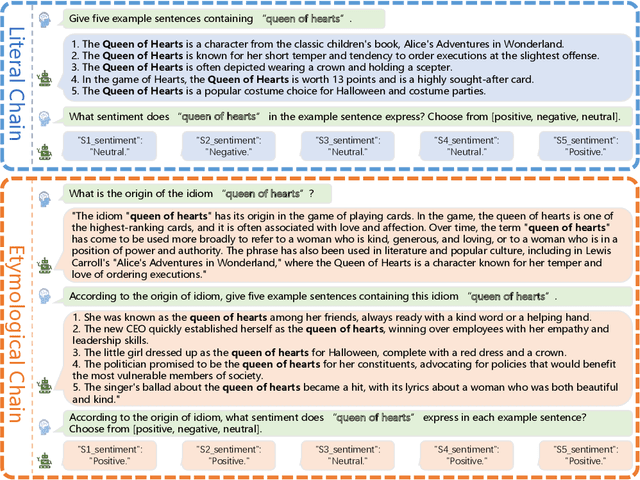

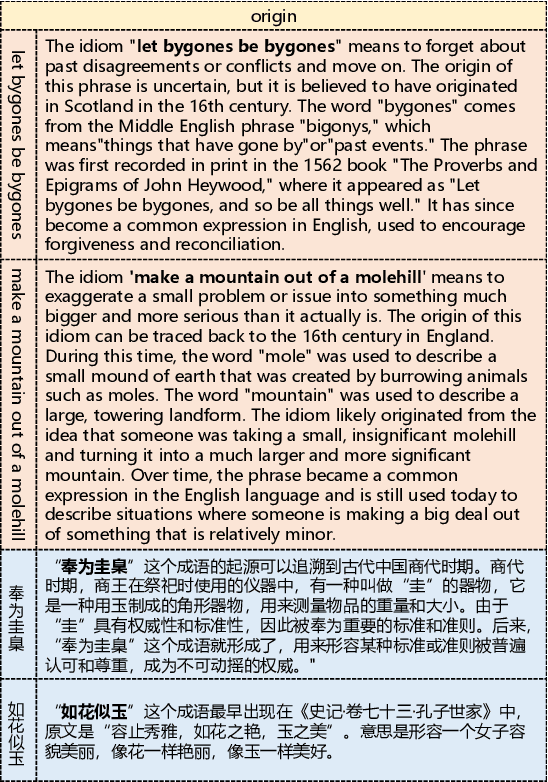
Abstract:Idioms represent a ubiquitous vehicle for conveying sentiments in the realm of everyday discourse, rendering the nuanced analysis of idiom sentiment crucial for a comprehensive understanding of emotional expression within real-world texts. Nevertheless, the existing corpora dedicated to idiom sentiment analysis considerably limit research in text sentiment analysis. In this paper, we propose an innovative approach to automatically expand the sentiment lexicon for idioms, leveraging the capabilities of large language models through the application of Chain-of-Thought prompting. To demonstrate the effectiveness of this approach, we integrate multiple existing resources and construct an emotional idiom lexicon expansion dataset (called EmoIdiomE), which encompasses a comprehensive repository of Chinese and English idioms. Then we designed the Dual Chain-of-Thoughts (DualCoTs) method, which combines insights from linguistics and psycholinguistics, to demonstrate the effectiveness of using large models to automatically expand the sentiment lexicon for idioms. Experiments show that DualCoTs is effective in idioms sentiment lexicon expansion in both Chinese and English. For reproducibility, we will release the data and code upon acceptance.
Training on the Benchmark Is Not All You Need
Sep 03, 2024



Abstract:The success of Large Language Models (LLMs) relies heavily on the huge amount of pre-training data learned in the pre-training phase. The opacity of the pre-training process and the training data causes the results of many benchmark tests to become unreliable. If any model has been trained on a benchmark test set, it can seriously hinder the health of the field. In order to automate and efficiently test the capabilities of large language models, numerous mainstream benchmarks adopt a multiple-choice format. As the swapping of the contents of multiple-choice options does not affect the meaning of the question itself, we propose a simple and effective data leakage detection method based on this property. Specifically, we shuffle the contents of the options in the data to generate the corresponding derived data sets, and then detect data leakage based on the model's log probability distribution over the derived data sets. If there is a maximum and outlier in the set of log probabilities, it indicates that the data is leaked. Our method is able to work under black-box conditions without access to model training data or weights, effectively identifying data leakage from benchmark test sets in model pre-training data, including both normal scenarios and complex scenarios where options may have been shuffled intentionally or unintentionally. Through experiments based on two LLMs and benchmark designs, we demonstrate the effectiveness of our method. In addition, we evaluate the degree of data leakage of 31 mainstream open-source LLMs on four benchmark datasets and give a ranking of the leaked LLMs for each benchmark, and we find that the Qwen family of LLMs has the highest degree of data leakage.
Lower Layer Matters: Alleviating Hallucination via Multi-Layer Fusion Contrastive Decoding with Truthfulness Refocused
Aug 16, 2024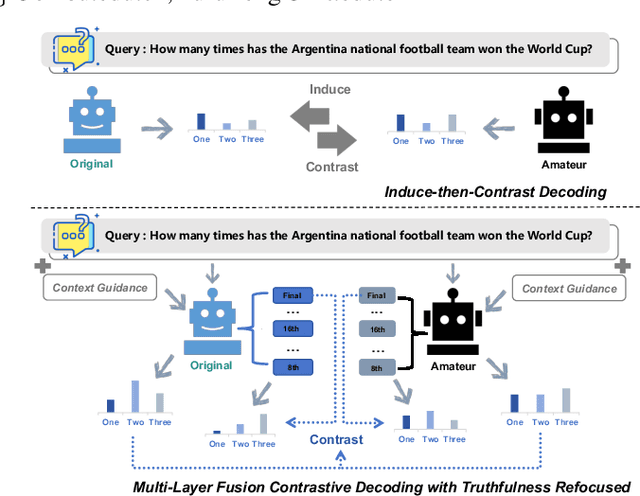
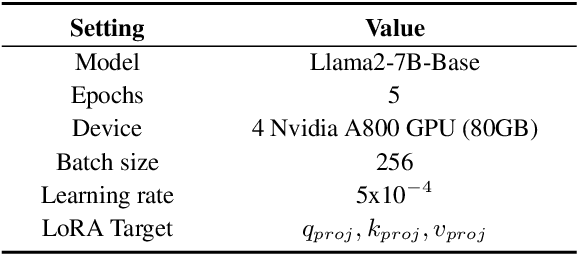
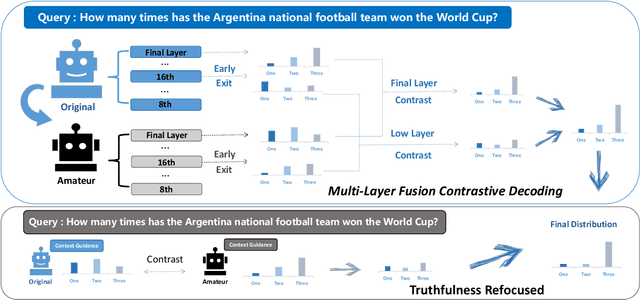
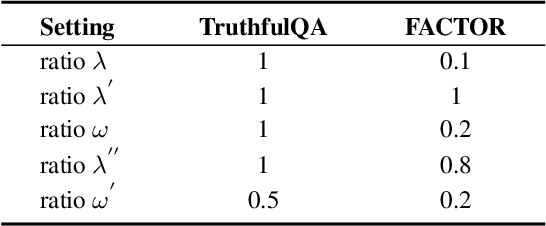
Abstract:Large Language Models (LLMs) have demonstrated exceptional performance across various natural language processing tasks, yet they occasionally tend to yield content that factually inaccurate or discordant with the expected output, a phenomenon empirically referred to as "hallucination". To tackle this issue, recent works have investigated contrastive decoding between the original model and an amateur model with induced hallucination, which has shown promising results. Nonetheless, this method may undermine the output distribution of the original LLM caused by its coarse contrast and simplistic subtraction operation, potentially leading to errors in certain cases. In this paper, we introduce a novel contrastive decoding framework termed LOL (LOwer Layer Matters). Our approach involves concatenating the contrastive decoding of both the final and lower layers between the original model and the amateur model, thereby achieving multi-layer fusion to aid in the mitigation of hallucination. Additionally, we incorporate a truthfulness refocused module that leverages contextual guidance to enhance factual encoding, further capturing truthfulness during contrastive decoding. Extensive experiments conducted on two publicly available datasets illustrate that our proposed LOL framework can substantially alleviate hallucination while surpassing existing baselines in most cases. Compared with the best baseline, we improve by average 4.5 points on all metrics of TruthfulQA. The source code is coming soon.
 Add to Chrome
Add to Chrome Add to Firefox
Add to Firefox Add to Edge
Add to Edge